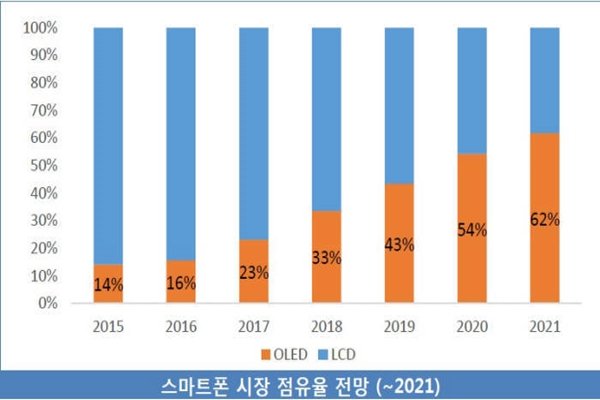It is predicted that competitions between rigid OLED and LTPS (Low-Temperature Poly-Silicon) LCD will start in earnest in markets for middle-grade Smartphones in 2017. Not only is Samsung Display planning to operate extension of facilities for rigid OLED starting from first quarter of 2017, depreciation of A1 and A2 that mass-produce rigid OLEDs has almost reached its limit.
According to an industry on the 30th, Samsung Display is planning to operate facilities for rigid OLEDs starting from early 2017 and start mass-producing them. Although size of investments is not big compared to flexible OLEDs, its plan is to use OLEDs for middle-grade and low-grade models of Smartphones.
Industries calculate that Samsung Display’s A2 Line is able to produce about 10,000 OLEDs per month. While A2 Line is producing about 180,000 OLEDs per month this year, it will be able to produce about 190,000 OLEDs per month next year. Compared to the fact that Samsung Display’s production capability of flexible OLEDs is increasing from 42,000 OLEDs per month in third quarter of this year to 150,000 OLEDs per month by end of next year, size of investment on rigid OLED is small.
However depreciation of A1 and A2 Lines is almost finished and environment of production is significantly stable due to introduction of new technologies for increasing yield of rigid OLEDs and output. Samsung Display is attempting new technologies at its lines for flexible OLEDs, which relatively lack stability in technologies, to increase yield and output. When yield and output increase, production cost can be decreased and it will also create a foundation for rigid OLED to be used in markets for low-grade models as well.

Although Chinese Smartphone manufacturers introduced new products with dual-edge panels recently, most of flagship models still use rigid OLED panels. When iPhone with flexible OLED appears in next year and output of Samsung Display increases, there is a possibility that Chinese Smartphone manufacturers will lower models with rigid OLEDs to medium-grade Smartphones.
Samsung Electronics is already working on lowering models with rigid OLEDs from medium-grade to low-grade models and has decided to use dual-edge OLED panels that are mostly used for flagship models for Galaxy A series which are medium-grade Smartphones. Models with rigid OLEDs out of Galaxy series will naturally become low-grade models.
This can naturally threaten position of LTPS LCD that has been dominating markets for flagship and medium-grade Smartphones.
Strength of small and medium-sized LTPS LCDs is high resolution. Although Chinese panel manufacturers planned investments that would convert lines for aSi (amorphous Silicon) LCDs to lines for LTPS LCDs, they either invested into oxide technologies that are needed to manufacture OLED boards or thought twice about converting lines as flexible OLEDs have become very popular.
A market research company called Ubi Research is estimating that percentages of OLED in global Smartphone markets will increase from 14% in 2015, 16% in 2016, 23% in 2017, and to 33% in 2018. It is estimating that OLED will take up 54% of global Smartphone markets in 2020.
Ubi Research is estimating that percentage of flexible OLED will be about 70% in all of OLED Smartphones in 2021 as many investments into flexible OLEDs are taking place in markets for small and medium OLED panels.
Staff Reporter Bae, Okjin | withok@etnews.com